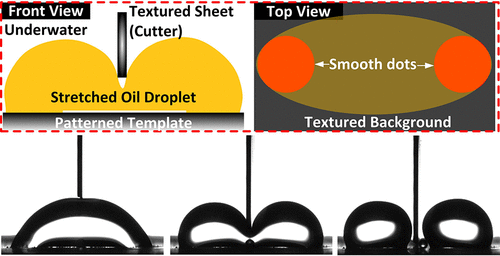Our official English website, www.x-mol.net, welcomes your
feedback! (Note: you will need to create a separate account there.)
Underwater Oil Droplet Splitting on a Patterned Template
Langmuir ( IF 3.7 ) Pub Date : 2017-11-16 00:00:00 , DOI: 10.1021/acs.langmuir.7b03604 Xiaolong Yang 1, 2 , Xin Liu 1 , Dennis W. Hess 2 , Victor Breedveld 2
Langmuir ( IF 3.7 ) Pub Date : 2017-11-16 00:00:00 , DOI: 10.1021/acs.langmuir.7b03604 Xiaolong Yang 1, 2 , Xin Liu 1 , Dennis W. Hess 2 , Victor Breedveld 2
Affiliation

|
Underwater oil droplets stretched and pinned by dual-dot oleophilic patterns on a superoleophobic substrate have been split into two nearly equal-volume daughter droplets using an underwater superoleophobic blade at substantially lower cutting speeds than reported in previous studies. A “liquid exchange model” based on Laplace pressure-driven liquid transport has been proposed to explain the mechanism of the underwater droplet split process. The dependence of droplet geometrical shape (curvature) and liquid properties (surface tension, viscosity) on the critical cutting speed that allows equal-volume split was investigated. Results demonstrate that critical cutting speed increases with increased curvature and surface tension of the split droplet, and decreases with increased droplet viscosity, which agrees with the proposed model. The ability to reproducibly split a single bulk oil droplet into daughter droplets with nearly equal volume facilitates the development of new functions for underwater microreactors.
中文翻译:

图案模板上的水下油滴分裂
使用水下超疏油刀片以比以前的研究报告的切割速度低得多的切割速度,将通过双点亲油性图案拉伸和固定在超疏油基质上的水下油滴分成两个等体积的子液滴。提出了一种基于拉普拉斯压力驱动的液体传输的“液体交换模型”来解释水下液滴分裂过程的机理。研究了液滴几何形状(曲率)和液体特性(表面张力,粘度)对允许等体积分裂的临界切削速度的依赖性。结果表明,临界切割速度随着分裂液滴的曲率和表面张力的增加而增加,并且随着液滴粘度的增加而降低,这与所提出的模型相符。
更新日期:2017-11-16
中文翻译:

图案模板上的水下油滴分裂
使用水下超疏油刀片以比以前的研究报告的切割速度低得多的切割速度,将通过双点亲油性图案拉伸和固定在超疏油基质上的水下油滴分成两个等体积的子液滴。提出了一种基于拉普拉斯压力驱动的液体传输的“液体交换模型”来解释水下液滴分裂过程的机理。研究了液滴几何形状(曲率)和液体特性(表面张力,粘度)对允许等体积分裂的临界切削速度的依赖性。结果表明,临界切割速度随着分裂液滴的曲率和表面张力的增加而增加,并且随着液滴粘度的增加而降低,这与所提出的模型相符。











































 京公网安备 11010802027423号
京公网安备 11010802027423号